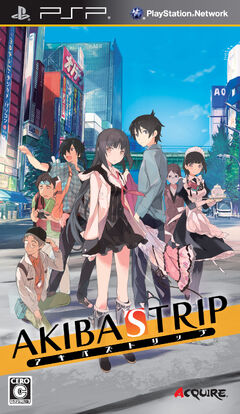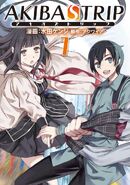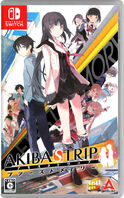(Editing a gallery) |
(Akiba's Trip west regions remastered release date has been updated to Summer 2021. Amazon release date: July 20, 2021.) Tag: Visual edit |
||
| Line 9: | Line 9: | ||
<b>Akiba's Trip: Hellbound & Debriefed (Western Regions)</b><br> |
<b>Akiba's Trip: Hellbound & Debriefed (Western Regions)</b><br> |
||
| − | + | July 20, 2021}}{{Nihongo|'''Akiba's Trip'''|アキバズトリップ|Akibazutorippu|'''AKIBA'S TRIP'''}} is a 2011 game for the PlayStation Portable (PSP) platform. It is the first game in the ''Akiba's'' series. The game was exclusively released in Japan. It is the first game in the ''Akiba's'' series. It was initially scheduled to be released on April 14, 2011 but became delayed. It was later released on May 19, 2011. The game received a sequel titled ''[[Akiba's Trip 2]]'' (also known as ''Akiba's Trip: Undead and Undressed''). |
|
A enhanced port titled {{Nihongo|'''''AKIBA'S TRIP PLUS'''''|アキバズトリップ プラス|Akibazutorippu Purasu}} was released on June 14, 2012 for Japan, with new additional features. |
A enhanced port titled {{Nihongo|'''''AKIBA'S TRIP PLUS'''''|アキバズトリップ プラス|Akibazutorippu Purasu}} was released on June 14, 2012 for Japan, with new additional features. |
||
| Line 18: | Line 18: | ||
Akiba's Trip: First Memory (Japan) | PlayStation 4 and Nintendo Switch | May 20, 2021 |
Akiba's Trip: First Memory (Japan) | PlayStation 4 and Nintendo Switch | May 20, 2021 |
||
| − | Akiba's Trip: Hellbound & Debriefed (Western Regions) | PlayStation 4, Nintendo Switch and Steam | |
+ | Akiba's Trip: Hellbound & Debriefed (Western Regions) | PlayStation 4, Nintendo Switch and Steam | July 20, 2021. |
== Story == |
== Story == |
||
Revision as of 01:18, 12 April 2021
Akiba's Trip (アキバズトリップ Akibazutorippu, AKIBA'S TRIP) is a 2011 game for the PlayStation Portable (PSP) platform. It is the first game in the Akiba's series. The game was exclusively released in Japan. It is the first game in the Akiba's series. It was initially scheduled to be released on April 14, 2011 but became delayed. It was later released on May 19, 2011. The game received a sequel titled Akiba's Trip 2 (also known as Akiba's Trip: Undead and Undressed).
A enhanced port titled AKIBA'S TRIP PLUS (アキバズトリップ プラス Akibazutorippu Purasu) was released on June 14, 2012 for Japan, with new additional features.
The game takes place in the the Japanese geek paradise Akihabara, and tasks players with battling vampire-like creatures called "Kageyashi" by stripping them down to their underwear, thus exposing them to sunlight, which knocks them out. In addition to the main plot, they can also engage in activities typical of the district, such as purchasing cosplay and visiting maid cafes
Remastered Versions
Akiba's Trip: First Memory (Japan) | PlayStation 4 and Nintendo Switch | May 20, 2021
Akiba's Trip: Hellbound & Debriefed (Western Regions) | PlayStation 4, Nintendo Switch and Steam | July 20, 2021.
Story
Game Overview
Akihabara, the popular Japanese culture hot-spot is stage to a vampire-based race called the Kageyashi and the youth of the protagonist becomes involved in fighting them in this action-based fighter.
The tie-up with real stores and companies, it is possible to experience the real Akihabara, from a realistic format to virtual. People who walk the streets, music flowing from the streets CM and each store, such as broadcasting, has been almost faithfully reproduced from the Akihabara of the time the game was released (some elements also exist that have been replaced by including the right relationship). The game has been characterized by taste, giving a feel as if walking into the real Akihabara.
Character voice can be heard as tweets and shouts on the field and battle, the audio of the event is only the beginning of the story. It should be noted that the company and the advertising of products related to Akihabara were inspired during the time of the game's release.
Plot - Route Branches
The game is sectioned into three branches and the follow-up route will be a result of the player and the options they had chosen previously. Each route consists of different backstories which may not be present or evident in other routes. In order to unlock all truths of the game, players will need to play through each story, paying attention to detail which may correlate to information from a corresponding route. This is also present in addition to those referred to as "sister route", but this only effects the epilogue of the game.
NIRO Route
Kageyashi Route
Coexistence Route
Characters
Akihiro Tanaka (田中アキヒロ Tanaka Akihiro) - The protagonist of the game. The default name of the player and can be changed before starting the game. He is a nerd in love with Japan's anime-manga culture and is the reason why he likes to visit Akihabara most of the time.
Nobukun (ノブくん Nobukun) - He is a friend of the player and in his 20s.
Gonchan (ゴンちゃん Gonchan)
Sara (サラ Sara)
Yatabesan (ヤタベさん Yatabesan)
Misaki Tanaka (田中美咲 Tanaka Misaki) - The sister of the protagonist, Akihiro. She is a shut-in who was about to take her pre-enrollment high school exams. She is a huge fans of cats and is affectionate towards her elder brother.
Kageyashi
Rui Fumitsuki (文月 瑠衣 Fumizuki Rui) - She is a Kageyashi who saves Akihiro from her elder brother. Depending on the route taken, she can assist as an ally or become an antagonist.
Yuu Abeno (阿倍野 優 Abeno Yuu) - He is the elder brother of Rui Fumitsuki and an antagonist.
Rei Anekoji (姉小路 怜 Anekoji Rei)
Sena Kitada (北田 瀬那 Kitada Sena)
Mana Kitada (北田 舞那 Kitada Mana)
Suzu Moriizumi (森泉 鈴 Moriizumi Suzu)
Shun Anekoji (姉小路 瞬 Anekoji Shun) - The brother of Rei Anekoji.
JKV - A girl encountered leading a group of five female high school students. She is labelled JKV, which is a Japanese abbreviation of high school girl five. Her real name is unknown. She can be seen in the opening animation sequence of the game.
NIRO
Satoko Midou (御堂 聡子 Midou Satoko)
Ryuuji Sejima (瀬嶋 隆二 Sejima Ryuuji)
Seigen Kitada (北田清源 Kitada) - The founder and investor of NIRO, as well as the father of Sena Kitada and Mana Kitada.
Gameplay
System
The mission stage of Akihabara is divided into seven blocks. The game has two classifications, one is "Main Mission" and the other is "Sub Mission". Any other event in the game can sometime occur during the main missions, as indicated on destination points. Players can freely explore Akihabara before the next main mission. It is also possible to leave Akihabara from the train station.
Sub Events can be seen away from the main story and can exchange details from the information store in the back alley. Payment and compensation can be received by clearing an event before a certain time period. Each client belongs to one of the main three forces, Akihabara Citizens, Kageyashi and NIRO. The reliability of each forces depends on how much the player clears.
Gameplay
Kageyashi have slipped onto the streets and the discrimination between them and human patterns exist to a minimum. The role of the player is to rid of the Kageyashi, but little difference is there between them and a human, therefore it is necessary to use the functions of the player's mobile camera to identify them before engaging in combat. Camera can be used before combat on humans but will take no effect and can be used at a low-angle of squatting if certain conditions are met.
The Kageyashi are capable of undressing others just like citizens. The more of the public present, the harder for both the Kageyashi and the player due to the imbalance of the two sides, depending on if the humans appear as enemy characters or not.
Combat is carried out using a special system called "strip action". Stripping is the main combat mechanism in Akiba's Trip, other than the Brawl Combat mechanic. It involves forcibly removing the target's clothing, thus exposing them to sunlight, to which Kageyashi are knocked out by. After sufficiently damaging an opponent's clothing with more conventional attacks, the user will get a "Strip Chance," which, if successful, may be chained to assault nearby opponents who have also had their clothing damaged. Clothes stripped can be sold or worn by the player themselves. The combat system is loosely based off of a previous project by Acquire titled "Supernatural -KAMIWAZA-".
The game includes a special police action where the police force engage in combat with the mob and the player. If the police work their way around they can attack the player, removing clothing from them and arrest them, as well as characters of the mob. If a fight is won against a police force, humans who have had their clothing removed will run away in that state of victory.
Akiba's Trip Plus
Differences
New features have improved of the previous port installation. AKIBA'S TRIP PLUS is an improved version of the former workings. With this, you add a large number of elements. Save data from the original version can be carried over as it is. Initially, June 21, was expected to be the release date but became one week ahead of schedule.
Changes:
- In the first version, voice overs were present during prologues and various cutscenes. PLUS grants the addition of full voice overs throughout the game.
- The original versions character 3D model compared to artwork was not very high in resolution or accuracy. PLUS greatly improved in this work, it has designs closer to the original picture. The camera work of the events scene have also been changed, so that the face of the character is visible well.
- Dub pre-secret live event of Sakuchu is animated, the song has also been newly written.
- Reproduced the Akihabara of 2012 release time, meaning a more modern or contemporary approach.
- Additional highest degree of difficulty "Holic", can be selected to the high degree of difficulty, "Otaku" mode after clearing the game.
- Strengthening of the crowded elements. Costumes, weapons additional appointments. There are also twice the number of sub-events than the original version.
- More costumes and nickname appreciation, as well as a picture book.
- Motion, strengthening of production.
- Shortening of reading time.
Development and Release
The development team, Acquire, decided that they wanted to create a game which visualizes Akihabara but is unique and holds a story of its own. The team later decided to take photographs of the city as reference and later began storyboarding ideas which led up to the game's development. The opening theme song is Dreamin' by ClariS. The character designer for the game was Hajime Mitsuda. The game seems to have drawn inspiration from all sorts of real-life music based in Akihabara, such as songs playing in streets or stall markets. The game mechanics seem to have been drawn from a previous game project done by Acquire (Akiba's series development team), called Supernatural -KAMIWAZA-.
Adaption
Akiba's Trip received a Gree mobile app version, as well as manga adaptions resulting in three volumes. The manga adaption was written by Dengeki Maou of ASCII Media Works, artwork by Kenji Mizuta and published in Comico Rise on April 27, 2012 and made it into the June issue sale. The story followed the regular route leading into the coexistence route.
Note: Gree link has been changed or doesn't work.
- "AKIBA'S TRIP" Dengeki Comics (all three volumes)
- First Printing September 27, 2012 issue ISBN 978-4-04-886917-1
- First Printing April 27, 2013 issue ISBN 978-4-04-891541-0
- First Printing December 21, 2013 issue ISBN 978-4-04-866182-9
Gallery
Trivia
- The name AKIBA'S TRIP is a portmanteau on the words Akiba in a possessive form and Trip. When combined, often written as a whole, AKIBA'STRIP—with the can be read "Akiba Strip", hence the stripping in-game.
Website Links
- Akiba's Trip Official Website (Japanese)
- Akiba's Trip Plus Official Website (Japanese)
- Akiba's Trip Remastered Official Website (Japanese)
- Akiba's Trip and Plus comparisons
















